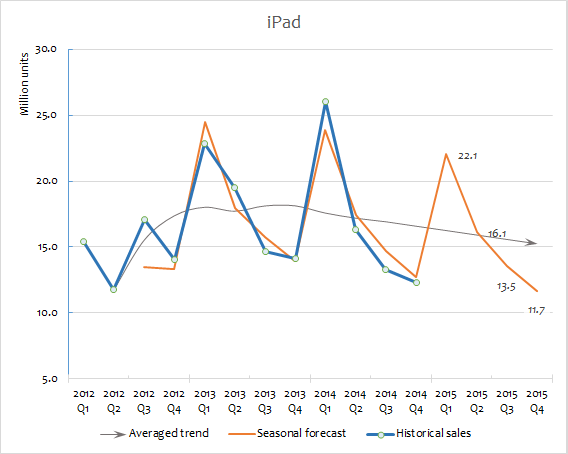After writing the article about the iPad and the ‘post-PC’ era, another idea came to my mind. I already gathered the data about Apple sales for the last three years from their public financial statements, why don’t I try to forecast the sales for the next year? In theory it should be pretty straightforward: sales of Apple devices follow a clear seasonal cycle, with higher sales in the first quarter (ending with the Christmas holidays) and lower sales in the following periods. There are statistical techniques for calculating the seasonal factors and trend and using these components to forecast the next quarterly sales.
The procedure I followed is this:
- calculate a centered moving average to obtain a trend free of seasonal factors;
- divide historical sales by this trend to calculate the seasonal factors for each quarter;
- average the individual seasonal factors to find the global factors for the entire series;
- extrapolate the growth trend for the next four quarters (assuming linear) based on the moving-average trend for the last 4–8 periods. I used 4 quarters in the trend estimation by iPad and Mac sales, because the trend is less clear than in the case of the iPhone and seems to be changing direction (iPad sales shrinking lately, Mac growing);
- finally, multiply the trend from the previous step with the seasonal factors to get individual forecasts for the next year.
The results: the iPhone forecast shows an estimated 60 Million unit sales for the next quarter (+/- 2 Mio.), which is probably a low estimate given the reported high demand for the new larger models. The iPad should sell around 22 Million units (+/- 2 Mio.), if the recent downward trend continues, dropping in the following quarters to 11.7 Mio. But the fit for the iPad is the lowest among the three, so it’s more likely that the actual numbers will deviate from this forecast. The next quarter should see Mac sales of about 5.2 Million (+/- 0.2 Mio.), growing to 6.1 Mio. in the final quarter of 2015.
| Quarter | iPhone | iPad | Mac |
|---|---|---|---|
| Q1 | 59.95 | 22.06 | 5.19 |
| Q2 | 48.71 | 16.10 | 4.79 |
| Q3 | 39.18 | 13.51 | 4.81 |
| Q4 | 40.91 | 11.68 | 6.05 |
| Total | 188.75 | 63.35 | 20.84 |



Looking at the seasonal factors for each product, I noticed something interesting: the distribution of sales between quarters is very similar for the iPhone and iPad (about one third of the yearly sales volume in the first quarter, 25% in the second and 20% in Q3 and Q4), but different from the Mac, where the highest sales happen in the forth quarter, about 28%. It looks the market considers the iPad more similar to an iPhone, with the ‘holiday effect’ slightly more pronounced for the iPad. On the other hand, Mac purchases are more evenly distributed throughout the year, meaning people are buying them when there’s a need, rather than during end-year promotions.

While playing with the numbers, there was something else that drew my attention: it looks like there are additional cycles in the sales data that could change the estimation considerably. The iPad has a secondary 3-quarter cycle and the Mac a 5-quarter cycle. By factoring them in, the fit between forecast and historical sales does improve, but, without a functional explanation about what drives these cycles, the results should be treated with caution. These could be random artifacts, and we will have to wait for another couple of quarters to see if they hold up. The new method predicts a grimmer outlook for the iPad, forecasting Q1 sales of only 17.9 Mio. units, dropping below 10 Mio. in Q4; combined for the year about 54 Mio. units, a good 10 Mio. less than the previous calculation. For the Mac, introducing the extra cycle doesn’t change the numbers considerably, only shifting sales between quarters: 5 Mio. in Q1, 6.4 Mio. in Q4, for a total of 20.5 Mio.


in fact, other indicators for seasonality, like autocorrelation, show no other cycles besides the obvious yearly rhythm, so it’s unlikely these cycles will continue.
2 comments:
The iPhone forecast was way off for Q1 while the iPad forecast (without the secondary cycle) was closer. Any iterations post the Q1 results to improve the accuracy of these forecasts for the next few quarters?
Yes, I expected the iPhone to be off, since the two new models are quite different from the previous line. If Apple had only launched one larger iPhone model, I suspect the forecast would have been much closer to the actual sales.
I plan to redo the analysis at the end of 2015, taking into account a full cycle of seasonal sales, that should yield better results than the single data point of Q1.
Post a Comment